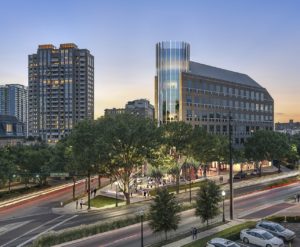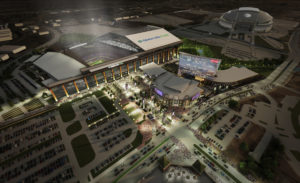Gloria Salinas, Managing Director, Economic Development
As the COVID-19 pandemic’s economic impact brings construction to a halt in most top markets, Dallas Region continues to build.
“We are moving forward on a vast majority of projects,” said Joe Haver, Principal at Corgan, a Dallas-based architecture and design firm. “We have prospective office towers in the downtown core that are moving full steam ahead, as well as projects that are under design.”

Cities in the Dallas Region have been among the fastest growing cities in the nation for years, and this trend continued before the pandemic hit. Investments and bond funds allocated to accommodate the momentum of growth will continue to move projects along, said Mike Rosa, the Dallas Regional Chamber’s Senior Vice President of Economic Development.
“There is no region in the U.S., for the past three years, that has had the job growth and corporate relocations that we’ve had,” Rosa said. “You don’t just stop an aircraft carrier or a freight train in five feet.”
In the region, Corgan currently has more than 700,000 square feet of commercial office space and an arts center under design and construction. Designing and building new spaces during an outbreak gives the firm a front row seat to finding innovative solutions to adapting its client’s spaces for a safe return to the office.
“We are having really thoughtful conversations around designing for back to work, from short-term to long-term implications,” said Amanda Hendrick, Corgan Vice President of Business Development. “Our approach for our clients is thoughtful and low-cost, but high-impact. There are immediate and easy things to implement, including hand dryers rather than paper towels, and HVAC with filtration systems that are more common in hospitals rather than office buildings.”
While there is no one-size-fits-all solution for getting back to the workplace, Corgan is exploring various impactful design elements to reestablish trust in the office environment, such as utilizing technology and security, Hendrick said.
“We look at ways we may adapt space and increase a feeling of safety and trust that has been lost in this pandemic,” she said.
Matt McDonald, Corgan Principal and Commercial Architect, said the design process during a pandemic requires architects and interior designers to solve for health and safety issues using health care principals of design.
“It’s like a moving target, and every single day we learn more and more,” McDonald said. “The three things to focus on for office design are operations, public space, and the janitorial operations, such as HVAC and ventilation practices, and the third piece is this legal overlay. Should you consult legal counsel?”
HKS, Inc. President and CEO Dan Noble said getting back to normal will require flexibility as a digital transformation takes place; a transformation that will blur health care design features across various sectors. For the past 15 years, HKS, a Dallas-based international architecture and design firm, has been the nation’s largest health care architect with about 45 percent of its work falling into the health care arena.
“We will start seeing design as the design of society, not just buildings,” Noble said. “We are in a grand experiment where many of us have been pleasantly surprised to learn that working from somewhere other than the office can not only be possible, but incredibly productive and beneficial.”
The National Bureau of Economic Research estimates 37 percent of all jobs in the U.S. can be done from home, which represents 46 percent of all wages, and perhaps speaks to the pause in real estate decisions as the Dallas Region construction market roars ahead.

“The shift toward true flexible work, even when we aren’t responding to a global pandemic, is long overdue,” Noble said pointing to the research. “This doesn’t mean the office will go away, but it will need to stretch and flex to redefine its role in knowledge work. This will carry over into every aspect of our lives.”
Noble said the real estate needs and trends will depend largely on the success of the new way of working. Over the past 15 years, offices have shifted from the large corner office and spaced cubicles to bullpen seating and the creation of higher density layouts with more people per square foot.
“With layoffs and retrenching going on, there will be footprint reductions and an increase in sublease space,” Noble said. “But on the other side, the real estate footprint for workers returning to an office may require more spacing, so square footage could stay the same to allow for social distancing.”
While there has been a pause in commercial real estate decisions, Rosa believes the sprawling build and real estate options of the region make it more appealing compared to other dense urban areas.
“We have a lot of advantages, including the sophistication and high-caliber of real estate, architecture, and engineering that is here,” Rosa said. “A majority of the site consultants we talk to envision corporate location activity returning to normal by the end of 2020.”
As HKS’ design and architecture projects haven’t really missed a beat and new projects approach the firm every day, Noble agrees that the market may see delayed real estate or business decisions, but the liquidity in the market will require the economy to rebound faster than the 2008 recession.
“We are very fortunate in terms of geography because our cities and projects are spread across the region, and we are in a very business friendly climate,” Noble said. “If any state jumps out quicker, it will be Texas.”
Top Dallas Region Office Building Markets
Ranked by square footage under construction in the first quarter:
-
- Legacy/Frisco: 1,303,607 square feet
- Las Colinas: 755,000 square feet
- East Dallas: 670,000 square feet
- Uptown-Turtle Creek: 644,244 square feet
- Richardson-Plano: 500,000 square feet
Total Dallas Region: 4,679,471 square feet
SOURCE: Cushman & Wakefield